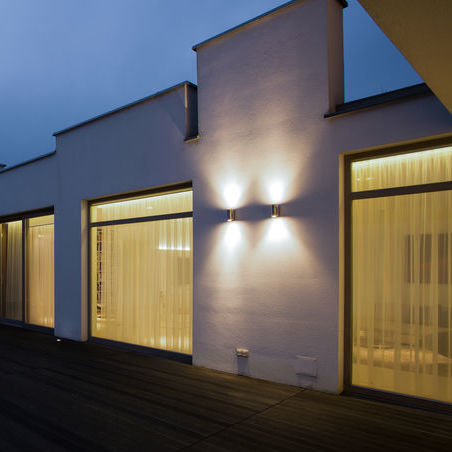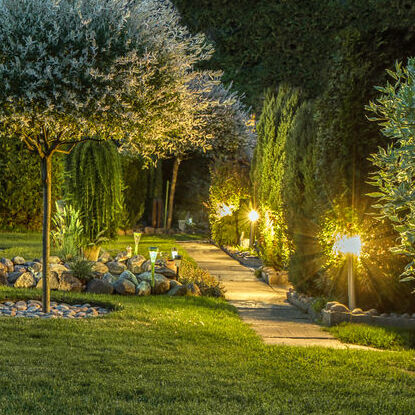What Type of Outdoor Lighting is Best?
Outdoor lighting can benefit homeowners in many ways. However, the question remains: which type of outdoor lighting is best? To review some of your options, please read over the following list to discover more.
- Flood lights. Flood lights can be quite useful for homeowners because they provide high brightness and a large coverage range. These lights are usually used for illuminating driveways and patios.
- Uplights/Downlights. These lights have lots of uses, and architecturally speaking, are great for highlighting certain features of a house.
- Step lights. As you may have guessed from the name, these lights are positioned on steps and illuminate up and down outdoor staircases.
- Garden lights. Orbs of light, these electrical editions to your garden can illuminate your favorite tree or ferns.

What are Outdoor Lights Called?
As you may have already surmised, there are plenty of different names for outdoor lights. One of the most popular names is “sconce”. The term “sconce” essentially is a term that is used for any kind of wall-mounted lighting. Sconces can provide ambient, accent, or task lighting depending on the kind of lighting that is desired.
Are LED Lights Good for Outdoor Use?
If you are wondering whether or not LED lights are good for outdoor use, you will be pleased to note that LED lights are remarkably effective outdoors. As a matter of fact, LEDs are a great choice for residential, commercial, and industrial lighting requirements. LEDs require little maintenance and low replacement costs.
What Color Temperature is Best for Outdoor Lighting?
One of the most important design decisions that you can make with regard to your outdoor lighting is the color temperature. The Kelvin range that is used in outdoor lighting is between 2500k-4000k. Warmer color temperatures are typically used on architectural elements. This means that “warm” lighting is between 2500-2700. Cooler temperature elements are used on plant material and gardens in an outdoor landscape. The color temperature for such installations is between 3000k to 4000k.
What is the Disadvantage of LED Light?
There are numerous advantages to LED lights. They require little maintenance, less energy, and are highly effective. However, it is important to consider any disadvantages if indeed there are any. According to a leading expert on lights in the manufacturing industry, LED lights only have a few inherent disadvantages. Perhaps the most well-known weakness of LED lighting is the fact that LEDs produce a byproduct. This byproduct is heat. LEDs are self-heating devices that generate heat inside the package versus radiating heat in the form of infrared energy.
Which Outdoor Lighting
When it comes to making your ultimate outdoor lighting selection, it is important to review all of your options. One of the best resources for property-owners is going to a lighting store and figuring out which lighting schemes will be best for their outdoor landscape. Whether this is a large furniture retailer or a home-improvement warehouse, it’s important to review as many applicable options as necessary. Having a well-informed opinion is the first step toward achieving your desired outdoor lighting outcome.
How to Choose Outdoor Lighting
It’s important to go in with a great mindset when it concerns choosing your outdoor lighting situation. The first thing that you need to do is deduce your outdoor lighting needs. Are you looking for more outdoor security? If so, you will want to review security light options. If you would like for your outdoor fixtures to be able to handle ice, snow, and intense rain, then it will be pertinent to select an outdoor fixture that has a wet rating. Outdoor fixtures with a wet rating can be installed on an exposed deck, on a veranda, on a gazebo, or on a pergola.
A UL wet rating means that the light can handle ice, snow, and intense rain. This rating also dictates that the fixture can handle salty conditions from the nearby ocean, and can be placed in an area of high exposure. Conversely, UL dry ratings indicate that the light is optimized for indoor use only. These lights cannot be exposed to any moisture and should never be used outdoors or in damp/wet locales.

Outdoor Lighting with Motion Sensor
One of the most important aspects of a good outdoor light fixture is whether or not it accomplishes all the goals you have. Does it turn off and on properly? Does it shine a light on the intended area? An outdoor light with a motion sensor accomplishes the task of ensuring that when people are passing near the light, it will turn on and off as needed. It can also be quite handy for detecting unwanted intruders on a property.
Our team are here to help with outdoor lighting in Fort Worth, TX. Please make an appointment at our company with a quick phone call to (817) 717-7737.
